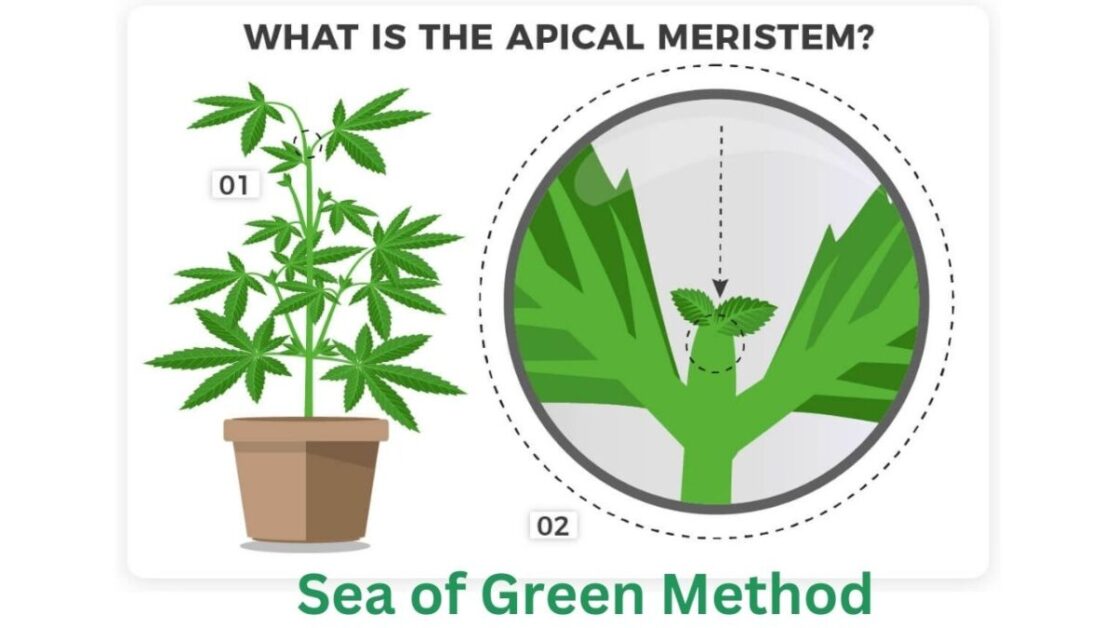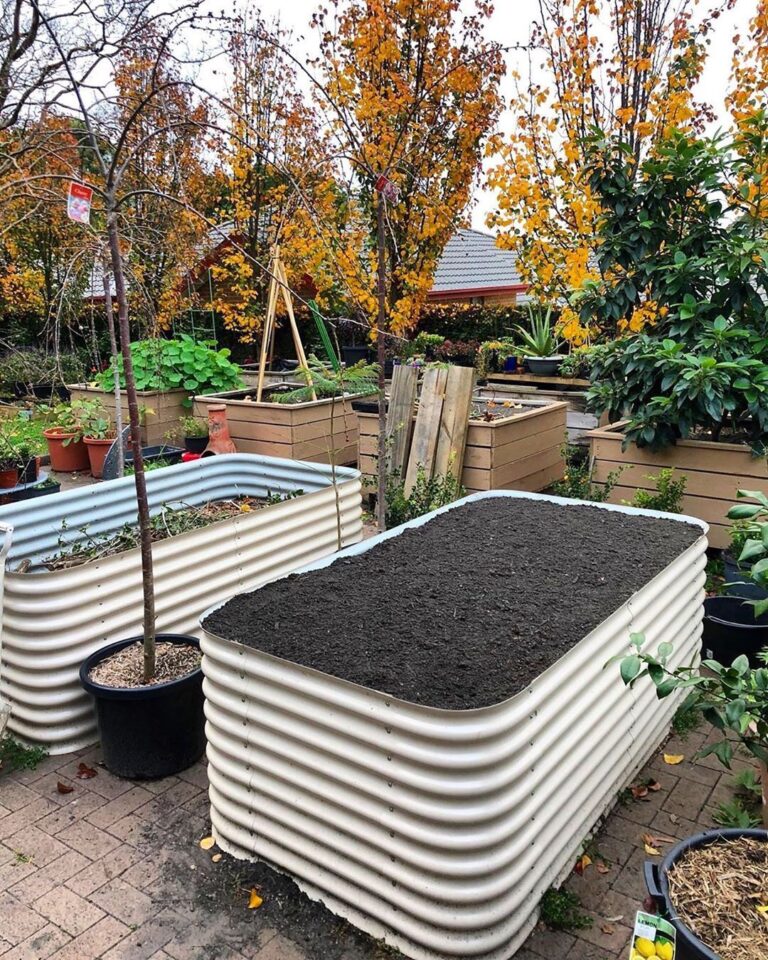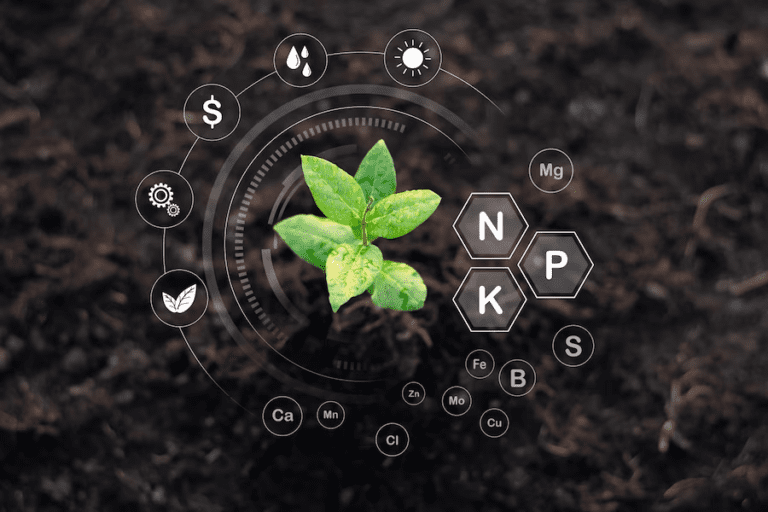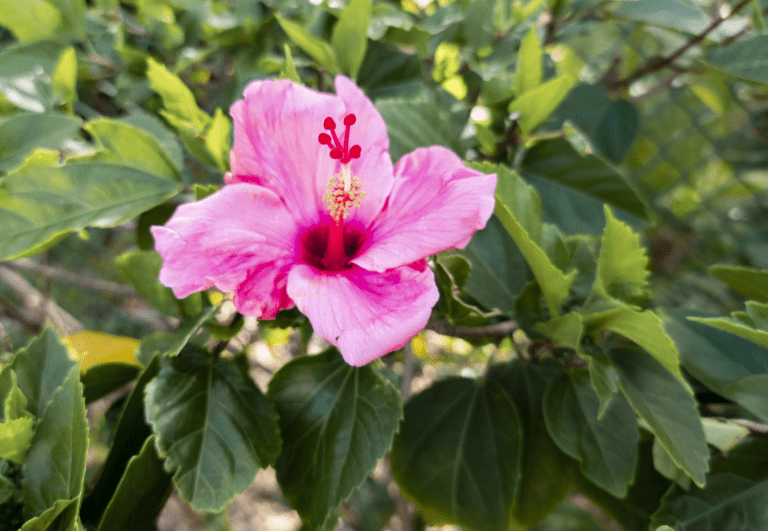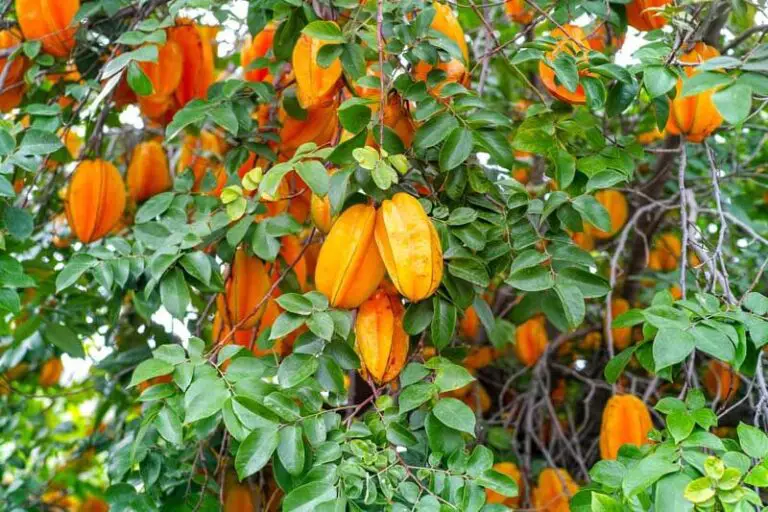Sea of Green Method: Best way to Use This Technique to Maximize Your Yield and Harvest
Table of Contents
Understanding the Sea of Green Method
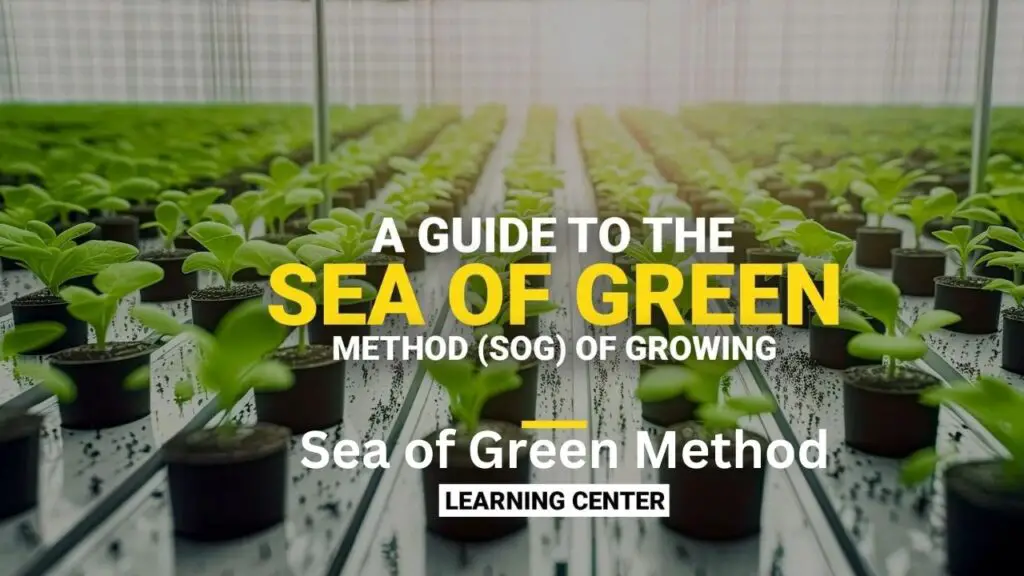
The Sea of Green method, also known as SOG, is a popular technique used by cannabis growers to maximize their yields. This method involves densely packing plants into a small space, allowing for a high number of plants to be grown simultaneously. The goal is to create a “sea of green” canopy, where plants grow closely together and receive uniform light distribution.
One of the main advantages of implementing the Sea of Green technique is its ability to produce a high yield in a relatively short amount of time. By growing multiple small plants instead of a few larger ones, growers can reduce the vegetative phase and quickly move on to the flowering stage. This can result in faster harvests and a more efficient use of resources such as water and nutrients. Additionally, the Sea of Green method can be especially beneficial for growers with limited space, as it allows for a higher plant density and maximizes the use of available growing area.
Advantages of Implementing the Sea of Green Technique
The Sea of Green (SOG) technique has gained popularity among cannabis growers for its numerous advantages. One of the biggest advantages of implementing the Sea of Green Technique is the significant reduction in vegetative growth time. By utilizing this method, cultivators can achieve faster flowering and shorten the overall time it takes to harvest their crops.
Another notable advantage of the Sea of Green Technique is the ability to maximize limited space. With this method, growers can efficiently utilize their growing area, making it an ideal choice for those with limited indoor space or for commercial growers who need to maximize their yields. By growing multiple smaller plants in a Sea of Green layout, cultivators can achieve a denser canopy and increase their overall yield per square footage.
Additionally, the Sea of Green Technique allows growers to achieve a more uniform crop. By planting numerous smaller plants rather than a few larger ones, the canopy is more even, resulting in a more consistent harvest. This consistency is especially beneficial for commercial growers who need to meet specific quality and volume requirements.
Moreover, the Sea of Green Technique also helps minimize the risk of mold, pests, and diseases. With a denser canopy, there is less chance for moisture to accumulate, reducing the risk of mold growth. Additionally, by growing multiple smaller plants, if one plant becomes infected or infested, it can be easily removed without affecting the entire crop.
In conclusion, the Sea of Green Technique offers several advantages to cannabis growers. From faster flowering and increased yields to maximizing limited space and achieving a more uniform crop, this method provides numerous benefits for both small-scale and commercial cultivators. By implementing this technique, cultivators can optimize their grow space, minimize risks, and ultimately increase their cannabis production.
Selecting the Right Cannabis Strains for the Sea of Green Method
When selecting cannabis strains for the Sea of Green method, it is important to consider a few key factors. First, you want to choose strains that have a short flowering time. This is because the Sea of Green technique relies on growing multiple plants in a small space and harvesting them quickly. Look for strains that have an average flowering time of 7 to 9 weeks.
In addition to flowering time, you should also consider the height and structure of the plants. Since the Sea of Green method involves training the plants to grow horizontally, it is best to choose strains that have a bushy and compact growth habit. This will allow for optimal light penetration and maximize your yield.
Preparing Your Growing Space for the Sea of Green Technique
When it comes to preparing your growing space for the Sea of Green technique, there are a few key considerations to keep in mind. First and foremost, you’ll need to ensure that you have enough space to accommodate multiple plants in a compact layout. This method is all about maximizing yield, so spacing between plants should be minimal.
In addition to space, lighting is another crucial aspect to consider. The Sea of Green technique relies heavily on providing the right amount of light to each plant. High-intensity discharge (HID) lights, such as metal halide or high-pressure sodium lamps, are popular choices for this method due to their ability to produce the intense light needed for optimal growth.
To ensure even light distribution, it’s important to position the lights at an appropriate height and angle. Remember that light intensity decreases significantly as distance from the light source increases, so adjusting the height of your lights accordingly is key. By creating an optimal lighting environment, you’ll be setting the stage for healthy and vigorous growth in your Sea of Green garden.
Setting Up an Efficient Lighting System for Maximum Yield
When it comes to setting up an efficient lighting system for maximum yield in your Sea of Green (SOG) cannabis garden, there are key factors to consider. Lighting plays a crucial role in the growth and development of your plants, and selecting the right type of lights can greatly impact their overall productivity.
First and foremost, it is important to understand the different types of lights commonly used in indoor horticulture. High-Intensity Discharge (HID) lights, such as Metal Halide (MH) and High-Pressure Sodium (HPS), have long been popular options due to their effectiveness and affordability. These lights emit a broad spectrum of light that closely mimics natural sunlight, promoting healthy plant growth.
However, Light Emitting Diode (LED) lights have gained significant traction in recent years for their energy efficiency and customizable features. LEDs have made significant advancements in technology, offering a wide range of spectrum options that can be tailored specifically to cannabis plants’ needs during each growth stage. LED lights also produce less heat, reducing the risk of heat stress on plants and allowing for closer placement to optimize light penetration.
In addition to selecting the right type of lights, proper placement and coverage are essential for an efficient lighting system. Aim to achieve even light distribution throughout your growing space, minimizing shadows and hotspots. Consider using reflective materials, such as Mylar or white paint, to bounce and diffuse light to the lower canopy of your plants. This ensures that each plant receives an adequate amount of light for optimal photosynthesis and, ultimately, maximum yield.
By carefully selecting the appropriate lights and implementing a strategic placement plan, you can create an efficient lighting system that maximizes yield in your Sea of Green garden. Stay tuned for our next article, where we will dive into proper nutrient management techniques to further optimize your SOG method’s success.
Proper Nutrient Management in the Sea of Green Method
Achieving proper nutrient management is essential in maximizing the potential of the Sea of Green method. By understanding the specific nutrient requirements of your cannabis plants and providing them with the right elements in the correct proportions, you can ensure optimal growth and abundant yields.
The first step in nutrient management is to choose high-quality fertilizers that are specifically formulated for cannabis cultivation. These fertilizers typically contain a balanced blend of essential macro and micronutrients, such as nitrogen, phosphorus, potassium, calcium, magnesium, and trace minerals. It is crucial to follow the manufacturer’s instructions regarding dosage and frequency of application to avoid over or underfeeding your plants.
In addition to the right nutrient composition, it is important to adjust the pH level of your nutrient solution. Cannabis plants thrive in a slightly acidic environment, with a pH range of 5.5 to 6.5. Maintaining this optimal pH level allows for better nutrient absorption and prevents nutrient deficiencies or toxicities. Regular monitoring of the pH level is crucial, and adjustments can be made using pH up or pH down solutions. By providing your plants with a nutrient-rich solution at the optimal pH, you can ensure vigorous growth and robust yields in your Sea of Green garden.
Proper nutrient management is just one aspect of successfully implementing the Sea of Green method. By understanding the science behind nutrient requirements and providing your plants with the right nourishment, you can create an environment that promotes healthy growth and bountiful harvests.
Watering and pH Control in the Sea of Green Technique
Watering and pH control are crucial aspects of the Sea of Green technique, as they directly impact the health and growth of the cannabis plants. Proper hydration and maintaining suitable pH levels enable plants to absorb nutrients effectively, ensuring optimal development throughout their life cycle.
When it comes to watering, it is essential to strike the right balance. Overwatering can suffocate the roots and lead to root rot, while underwatering can cause nutrient deficiencies and stunted growth. To determine the ideal watering schedule, consider factors such as the size of the plants, the size of the pots or hydroponic system, and the environmental conditions. Generally, it is recommended to water the plants when the top layer of soil feels dry to the touch, ensuring that excess water drains out through the drainage holes.
In addition to proper hydration, maintaining the correct pH range is crucial to maximize nutrient absorption. Cannabis plants thrive in slightly acidic to neutral conditions, with a pH range of 5.8-6.3 for hydroponic systems and 6.0-6.5 for soil-based setups. Deviating from this range can result in nutrient lockout, where the plant cannot access essential elements, even if they are present in the growing medium. Regular pH monitoring and adjustment using pH meters and pH-up or pH-down solutions are necessary to maintain a healthy and balanced environment for the plants.
By understanding the importance of watering and pH control in the Sea of Green technique and implementing best practices, growers can create the optimal conditions for cannabis plants to flourish. However, it is important to note that individual strains may have specific preferences when it comes to watering frequency and pH levels. Therefore, it is recommended to research and select strains that are well-suited for this method and adapt the watering and pH control techniques accordingly.
Training and Pruning Techniques for Improved Yield
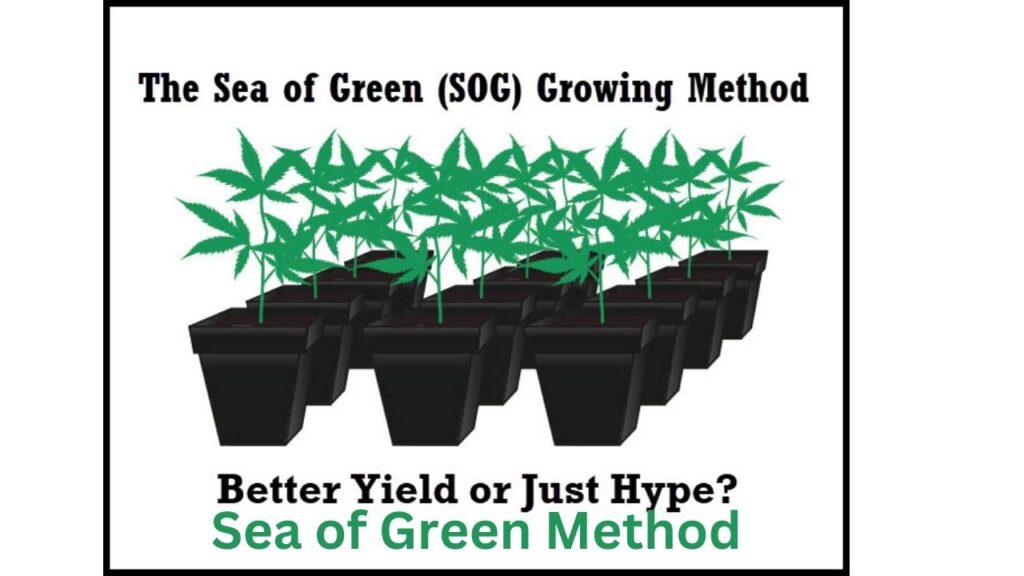
To achieve optimal yields in the Sea of Green method, it is crucial to employ effective training and pruning techniques. Proper training and pruning not only help maximize the use of space but also promote healthier and more abundant bud development. Here are some key practices to consider:
1. Topping: Topping involves removing the top growth, also known as the apical meristem, of the plant during the vegetative stage. This technique encourages lateral branching, allowing for more colas to form and increasing overall yield potential. Make sure to use clean pruning shears and make a precise cut just above the node.
2. LST (Low-Stress Training): LST is a training method that involves gently bending and securing the branches of the plant to encourage horizontal growth. By manipulating the growth pattern, LST promotes more even light distribution, better nutrient uptake, and improved airflow. This technique helps prevent the plant from becoming top-heavy and ensures that all flowers receive equal light exposure, resulting in more consistent bud development.
Remember, a balanced approach is essential when implementing training and pruning techniques. While it is crucial to remove excess foliage to improve light penetration and airflow, excessive pruning can stress the plant and negatively impact overall growth. Always monitor your plants closely and adjust your training and pruning techniques accordingly.
Maintaining Ideal Temperature and Humidity Levels
To ensure optimal growth and yield in the Sea of Green (SOG) method, maintaining ideal temperature and humidity levels is crucial. The environmental conditions directly impact the plant’s metabolic processes, nutrient uptake, and overall health. Thus, it is essential to create a stable and controlled microclimate for your cannabis plants.
Temperature control is key when it comes to the SOG technique. Ideally, the temperature should be maintained between 70°F and 80°F (21°C to 27°C) during the lights-on period, and slightly lower, around 10°F (5°C) below, during the lights-off period. These temperature ranges promote healthy photosynthesis and minimize the risk of stress or heat-related damage to the plants. It’s worth noting that different strains may have specific temperature preferences, so it’s advisable to research the optimal range for the particular varieties you are growing.
Humidity levels also play a critical role in the success of your SOG garden. During the vegetative stage, aim for a humidity range of 50% to 70%. This range helps prevent moisture-related issues such as mold and mildew while providing enough moisture for the plants to transpire and grow vigorously. As the plants transition into the flowering stage, gradually reduce the humidity to around 40% to 50% to prevent excess moisture from interfering with bud development and potentially causing bud rot.
By carefully monitoring and controlling temperature and humidity levels, you can create an environment that fosters healthy growth and maximizes the potential of your cannabis plants in the Sea of Green method. Next, we’ll explore various ways to prevent and manage pests and diseases in this unique growing technique.
Preventing and Managing Pests and Diseases in the Sea of Green Method
One of the most crucial aspects of successfully implementing the Sea of Green method is preventing and managing pests and diseases. As cannabis plants are highly susceptible to various pests and diseases, proactive measures should be taken to ensure a healthy and thriving crop.
To begin with, regular scouting and inspection of your plants is essential for early detection of any issues. This can include checking leaves, stems, and buds for signs of pests or diseases such as yellowing, discoloration, spots, or wilting. Additionally, keeping a close eye on the overall health and vigor of your plants will help you identify any abnormalities early on.
Implementing preventative measures such as proper sanitation and cleanliness is also vital for keeping pests and diseases at bay. This includes regularly removing any dead leaves or plant matter from your growing area, as these can serve as breeding grounds for bacteria, fungi, and pests. Maintaining a clean and well-ventilated space will help reduce the risk of infestations and diseases taking hold.
Harvesting and Curing Tips for the Sea of Green Technique
When it comes to harvesting and curing your cannabis plants in the Sea of Green technique, timing is everything. It is crucial to wait until your plants have reached their peak potency and cannabinoid production before harvesting. This typically occurs when the majority of the trichomes on the buds have turned cloudy or milky in color. Keep a close eye on your plants and use a jeweler’s loupe or a portable microscope to examine the trichomes closely. Once you determine that your plants are ready for harvest, it’s time to start the drying and curing process.
Proper drying and curing are essential steps in maximizing the quality and flavor of your Sea of Green harvest. After harvesting, carefully trim off any excess foliage and hang your plants upside down in a cool, dark, and well-ventilated space. Make sure to maintain a temperature of around 65-75°F (18-24°C) and a humidity level of around 45-55% during the drying phase.
This will allow the buds to dry slowly and evenly, preserving their aroma and potency. Once the smaller stems snap instead of bend, it’s an indication that the buds are sufficiently dry and ready for the next step: the curing process. Transfer the dried buds to glass jars and store them in a cool, dark place, burping the jars daily for the first week to release any excess moisture. This process can take anywhere from two to six weeks, depending on your personal preference. The longer you cure your buds, the smoother and more flavorful they will become. So be patient and allow the curing process to work its magic.
Troubleshooting Common Issues in the Sea of Green Method
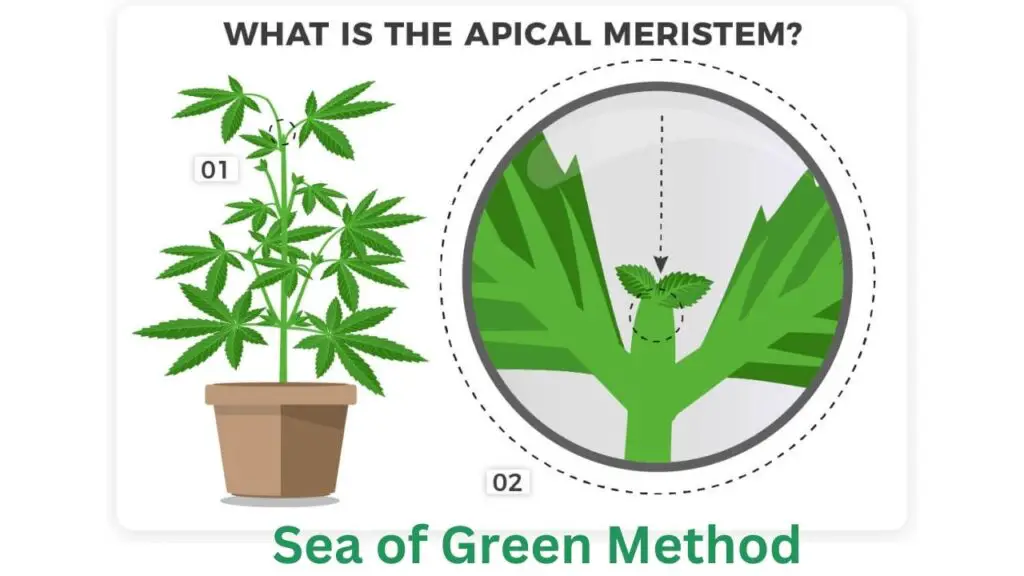
When it comes to implementing the Sea of Green method in cannabis cultivation, troubleshooting common issues may arise that can affect the overall growth and yield of your plants. One common issue that growers may encounter is nutrient deficiency or excess, which can manifest through yellowing or browning of leaves, stunted growth, or wilting. Monitoring and maintaining proper nutrient levels is crucial to ensure healthy plant development.
Another issue that growers may face is pest infestation, which can greatly impact the success of the Sea of Green technique. Common pests such as spider mites, aphids, or fungus gnats can quickly spread throughout the growing space and cause damage to the plants. Timely detection and proactive pest management strategies, such as introducing beneficial insects or using organic pest control methods, can help prevent and minimize pest-related problems.
Here’s a table with information about the Sea of Green (SOG) method in cannabis cultivation:
| Aspect | Details |
|---|---|
| Method Name | Sea of Green (SOG) |
| Objective | Maximize yields by maintaining a canopy of small, closely spaced plants and inducing flowering early. |
| Number of Plants | Typically, many small plants (clones or seedlings) are grown closely together to form a continuous canopy. |
| Growing Medium | Soil, coco coir, or hydroponic systems can be used. |
| Training Techniques | – Minimal training: Focus on maintaining an even canopy. – Lollipopping: Remove lower branches and foliage to redirect energy to upper buds. |
| Lighting | – High-intensity discharge (HID) or LED lights are commonly used. – Maintain a consistent light cycle (usually 18/6 during the vegetative phase and 12/12 during flowering). |
| Vegetative Phase Duration | Short vegetative phase; plants are induced to flower soon after reaching a small size (usually 2-3 weeks). |
| Flowering Phase Duration | Short flowering period due to early induction; varies based on the cannabis strain being cultivated. |
| Harvest Time | Typically faster harvests compared to other methods due to the shorter overall growth cycle. |
| Yield per Area | Higher yields per square foot due to the close spacing of plants and efficient use of grow space. |
| Space Management | Requires close spacing between plants, often as close as 1-2 square feet per plant. |
| Nutrient Management | Regular monitoring and feeding with a balanced nutrient solution based on the plant’s growth stage. |
| Pest and Disease Control | Close spacing may increase the risk of pests and diseases; proactive measures are essential. |
| Advantages | – Rapid turnover and continuous harvests. – Efficient use of space and resources. – High yields with proper management. |
| Challenges | – Requires careful monitoring and management. – Susceptible to issues spreading quickly due to close spacing. |
| Training Level | Suitable for both beginner and experienced growers. |
| Legal Considerations | Adhere to local laws and regulations regarding the cultivation of cannabis. |
| Popular Strains | Various cannabis strains can be used, but those with shorter flowering times are often preferred. |
| Learning Resources | Numerous online guides, forums, and resources offer insights into implementing the Sea of Green method. |
This table provides an overview of key aspects related to the Sea of Green (SOG) method in cannabis cultivation, covering various factors such as training techniques, lighting, nutrient management, and advantages and challenges associated with this method.
Success Stories and Testimonials from Sea of Green Growers
The Sea of Green method has gained immense popularity among cannabis growers due to its impressive results and efficiency. Many growers have reported significant success using this technique, achieving higher yields and faster turnaround times. One grower, John Smith, shared his experience, stating, “Implementing the Sea of Green method completely transformed my cultivation process. I have seen a substantial increase in yield, and the overall quality of my harvests has improved. This technique has allowed me to maximize the use of my growing space and cut down on the vegetative stage, resulting in a quicker harvest cycle.”
Another grower, Emily Johnson, echoed similar sentiments, saying, “I was initially skeptical about the Sea of Green method, but after implementing it, I was blown away by the results. The plants grew uniformly and compactly, resulting in a dense sea of lush green foliage and abundant buds. Not only did I achieve impressive yields, but the overall quality and potency of my harvest significantly improved.”
These success stories and testimonials from experienced Sea of Green growers highlight the undeniable advantages of this technique. As more growers discover its benefits, the Sea of Green method is becoming increasingly popular in the cannabis cultivation community.
What is the Sea of Green Method?
The Sea of Green Method is a technique used by cannabis growers to maximize yield by growing multiple smaller plants in a small space and utilizing a shorter vegetative phase.
What are the advantages of implementing the Sea of Green Technique?
The Sea of Green Technique allows for faster harvest cycles, increased yield per square foot, better light penetration, and efficient use of resources such as water and nutrients.
How do I select the right cannabis strains for the Sea of Green Method?
When selecting strains for the Sea of Green Method, it is important to choose varieties that are known for their compact size, quick flowering time, and high yield potential.
How do I prepare my growing space for the Sea of Green Technique?
To prepare your growing space for the Sea of Green Technique, you need to ensure proper ventilation, sufficient lighting, appropriate temperature and humidity levels, and adequate spacing between plants.
How can I set up an efficient lighting system for maximum yield?
To achieve maximum yield in a Sea of Green setup, it is recommended to use high-quality grow lights such as LEDs or HIDs, and position them properly to provide uniform light distribution to all plants.
What is the proper nutrient management in the Sea of Green Method?
Nutrient management in the Sea of Green Method involves using a balanced fertilizer regimen specifically formulated for cannabis, adjusting nutrient levels as plants progress through different growth stages, and regularly monitoring pH levels.
How should I manage watering and pH control in the Sea of Green Technique?
It is important to water plants in the Sea of Green Technique when the top layer of the growing medium is dry. pH levels should be monitored and adjusted to maintain a slightly acidic range between 5.5 and 6.5.
What training and pruning techniques can improve yield in the Sea of Green Method?
Techniques such as low-stress training, topping, and defoliation can be used to manipulate plant growth, promote lateral branching, and increase light exposure to lower canopy areas, resulting in improved yield.
How do I maintain ideal temperature and humidity levels in a Sea of Green setup?
Ideal temperature for cannabis plants in the Sea of Green Method is between 70-85°F (21-29°C), while humidity should be kept around 40-60% during the vegetative phase and reduced to 30-50% during flowering.
How can I prevent and manage pests and diseases in the Sea of Green Method?
Preventing pests and diseases in the Sea of Green Method involves maintaining a clean growing environment, using organic pest control methods, regularly inspecting plants for signs of infestation or disease, and promptly addressing any issues that arise.
What are some harvesting and curing tips for the Sea of Green Technique?
During harvest, it is best to cut plants at the base and hang them upside down in a well-ventilated, dark room with temperatures around 65-75°F (18-24°C). Curing involves drying buds slowly in jars with regular burping to achieve optimal flavor and potency.
How can I troubleshoot common issues in the Sea of Green Method?
Common issues in the Sea of Green Method include nutrient deficiencies or excesses, light burn, pH imbalances, pests, and diseases. Troubleshooting involves identifying the problem, adjusting environmental conditions or nutrient levels, and taking appropriate corrective measures.
Are there any success stories or testimonials from Sea of Green growers?
Yes, many growers have reported successful yields and increased efficiency using the Sea of Green Method. Their experiences and testimonials showcase the potential of this technique in producing high-quality cannabis.

